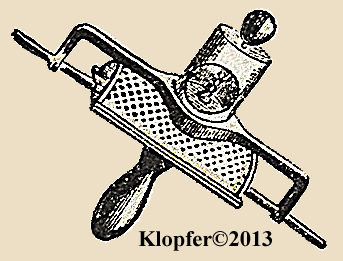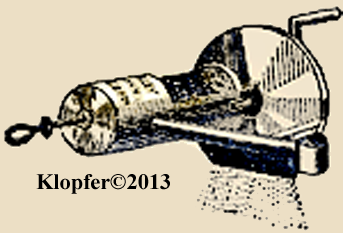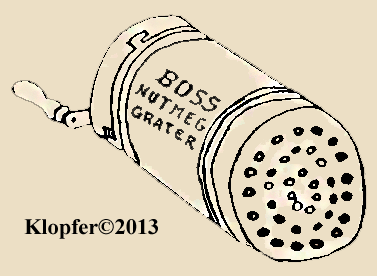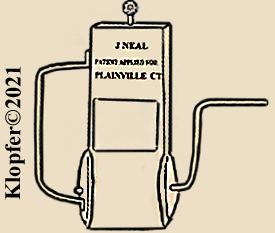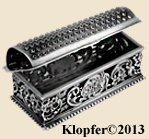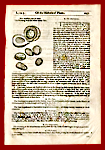 Click Me!
Click Me!
NutmegGraters.Com

- Home
- Featured Stories
- Picture Gallery
- Info.Wanted :
- Spurious Marks
- Trading Post
- Contact Our Site
- Wanted To Buy
[WELCOME: My articles published on NutmegGraters.Com and commercially (elsewhere) required many years of primary research, personal expense, travel and much effort to publish. This is provided for your enjoyment, it is required that if quoting my copyrighted text material, directly provide professionally appropriate references to me. Images are unavailable for copy. Thank you J. Klopfer.]
_______________________________________________________________________________________________________________________________________________________
The Primitive Nutmeg Grater ~ Many Definitions
Manufacturing technologies of long ago remain available to our present day craftspeople, which sometimes raise questions: Is this artifact a period piece? Just when was this primitive appearing item actually created? Is this item authentic; a reproduction; a fake? Is there a chain of provenance for this item providing evidence of antiquity? Is this item unique or one produced in large quantities (mass-produced)? Do Victorian factory-produced kitchen implements, including some nutmeg graters assembled into the hundreds of thousands, really fall under a heading of "primitive"?
During these modern times, the word "primitive" has evolved to carry a variety of meanings. To avoid some of the currently less flattering, devaluative or pejorative connotations ["primitive" ~ a.k.a. old country, vintage, rustic, kitcheny, folksy, utilitarian, shabby chic, etc.], NutmegGraters.Com turns to the more classical definition found within Webster's Third New International Dictionary, 1961: "prim•i•tive ~ Of or relating to the early age or period (PRIMEVAL); little evolved and closely approximating an early ancestral type (ARCHAIC); belonging to and characteristic of an early stage in development (RUDIMENTARY)".
Whatever your definition is, NutmegGraters.Com is pleased to explore a variety of fine, classical and distinctive examples of primitive implements typically used to grate nutmeg.
![]()
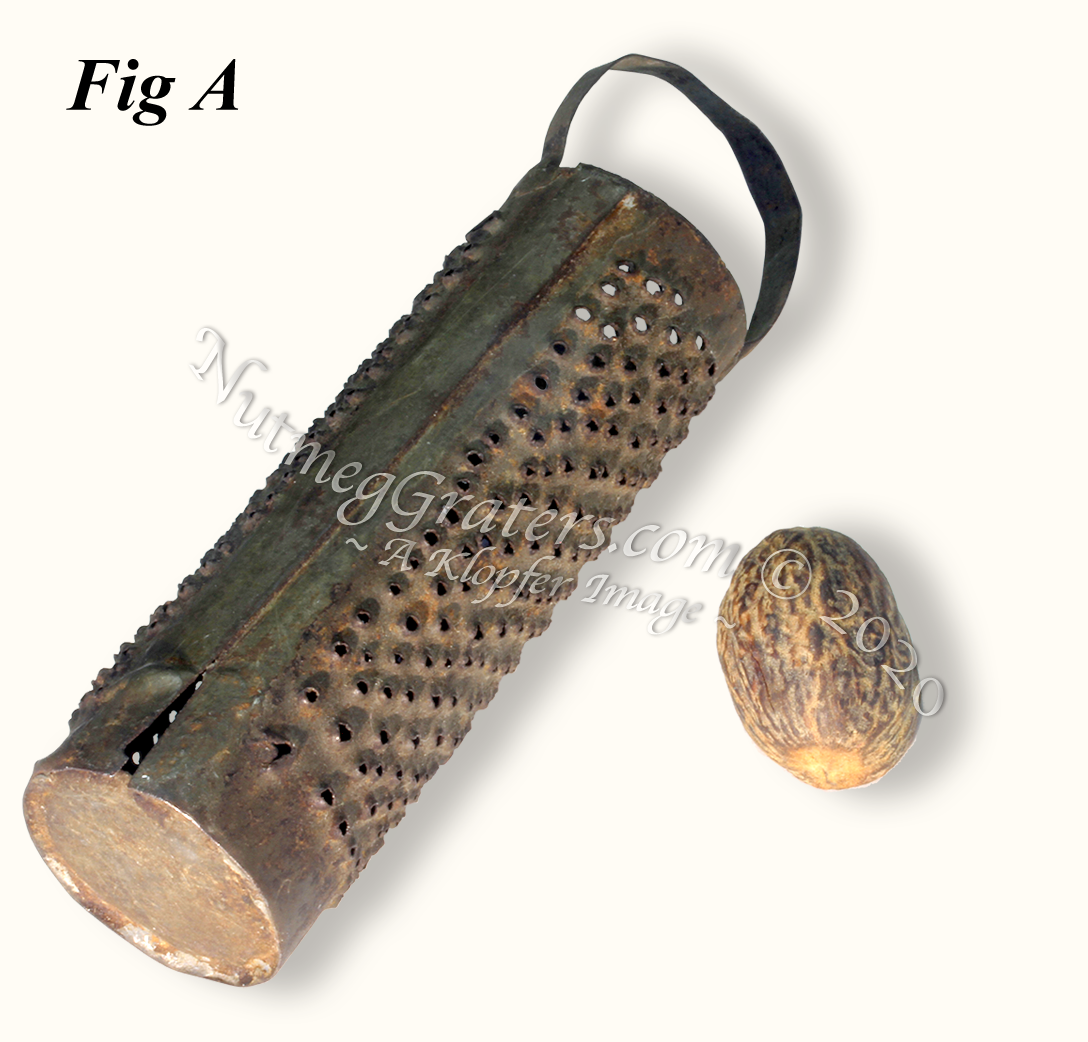 PRIMITIVE (Fig A) ~ A Tin Cylinder Basket Form Nutmeg Grater With Handle:
PRIMITIVE (Fig A) ~ A Tin Cylinder Basket Form Nutmeg Grater With Handle:
American, unmarked, tin, likely made Southern New England to Pennsylvania, Circa 1830. STATS: 3⅓" body's height (4⅛" total height with handle); 1" Diam. (3½" around) : .05 oz.
As a container, this stores 5 nutmegs inside when not in use.
PROVENANCE: A well documented collector's provenance dating prior to 1960.
 In 1983, Phil Echert, Master Tinsmith from Old Sturbridge Village, Massachusetts, explained that "the measurements with these nutmeg graters are always identical" ...(in size). "This is because they were cut from a standard sized tin sheet which measured 14 by 10 inches"; this resulted into 12 equally sized pieces of tin ~ 3⅓" by 3½". The tinsmith would punch-work each flat sheet by hand before rounding them into a cylinder, using simple-soldering to fasten the unseamed edges together. Nothing of tin sheets went to waste; both the circular bottom piece and the strap handle on top were cut from scrap tin.
In 1983, Phil Echert, Master Tinsmith from Old Sturbridge Village, Massachusetts, explained that "the measurements with these nutmeg graters are always identical" ...(in size). "This is because they were cut from a standard sized tin sheet which measured 14 by 10 inches"; this resulted into 12 equally sized pieces of tin ~ 3⅓" by 3½". The tinsmith would punch-work each flat sheet by hand before rounding them into a cylinder, using simple-soldering to fasten the unseamed edges together. Nothing of tin sheets went to waste; both the circular bottom piece and the strap handle on top were cut from scrap tin.
From the eighteenth century, tin coated sheets of thin iron plate were imported from South Wales and West Midlands England into America's northern industrial area ports. Between the American Civil War (1865) and WWI (1914), a handful of large, urban American industrial manufactures began to produce large rolled sheets of tinned iron for their own use, but for the most part, American tinsmiths continued to import packaged tin sheets from British pack mills. Although the McKinley Tariff of 1891 caused reduction to Britain's tinplate industry, American import of boxed English tin sheets continued well into the 20th century. By the 1930's, more modern metals replaced tinned iron plate.
To further illustrate history of imported tinplate, notice the simple receipt dated 1838 (Fig B) which approximates the same period as this nutmeg grater. Listed is the "Nathen Trotter Co." of Philadelphia, who from 1789 were importers of tinplate from England. Still in business today, they remain the oldest continuously operating metals company in the United States. Also from Philadelphia and named on this invoice, Bolton & Co. was a "forwarding warehouse" (a.k.a.: shipping company). Notice images of a steam locomotive and a horse drawn canal barge at the top of their invoice; these both were the shipping methods available through Bolton & Co. Listed as recipient, Joseph Graffius would receive transport of "12 Box tin, 1 Bdl (bundle) Wire, 1 (bundle) tin" delivered to "Wmport" (probably: Williamsport, Lycoming County, Pennsylvania). Within available records, a Joseph Graffius was found in Williamsport, who's father Abraham Graffius (1756-1830) had been a tinsmith until his death. Also found were several individuals named Graffius (including a Joseph Graffius), each who acquired 400 acre land parcels in Lycoming County Pennsylvania in 1830 ~ the year Abraham Graffius died. This is suggestive that Joseph may have carried on his father's tinsmithing business after his father's death, but no records are yet known to confirm this. [NOTE: The receipt spells Joseph's name "Grafius" on the face, but "Graffius" on the reverse.] This invoice documents the typical means by which American tinsmiths obtained their supplies during the 18th and 19th centuries.
The tinsmithing technologies from colonial times still remain available to contemporary tinsmiths, and using repurposed antique tinned iron, this primitive styled nutmeg grater can easily be reproduced today. In knowing why these exact measurements originate, modern collectors develop the sense to question authenticity with a nutmeg grater of similar construction but that differs in size and proportions to these originals. Beware!
![]()
PRIMITIVE (Fig C) ~ A Combination Punch Mixing Spoon & Nutmeg Grater Plus Storage Compartment:
Unique: American, unmarked, maple and tin, late 18th or early 19th century.
STATS: 12" long; 1½" width : 3.277 oz. ~ ⅕ lb. weight.
PROVENANCE: Americana Auction, Paul McInnis Auction, Hampton Falls, NH 03844 ~ 1/9/1988 ~ item's prior provenance withheld.
ANALYSIS:
Wood Identified (2009): "American Maple" by Dr. R. Bruce Hoadley, Wood & Science Technology Holdsworth Natural Resources Center, University of Massachusetts, Amherst, Massachusetts 01003; Author of: Understanding Wood: A Craftsman's Guide to Wood Technology & Identifying Wood: Accurate Results With Simple Tools.
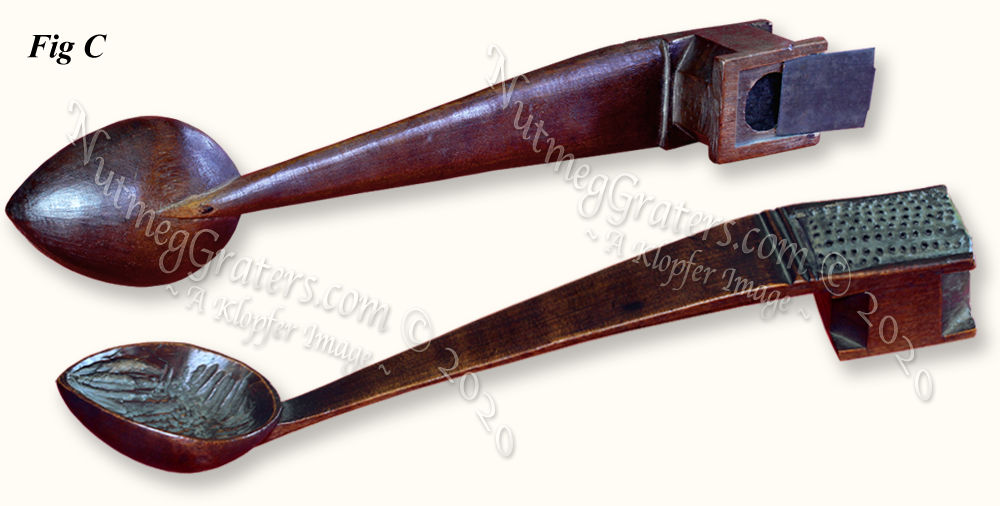
![]()
PRIMITIVE (Fig D) ~ A Long Handled Bottom Grater For Nutmeg:
Unique, American, unmarked, basswood and tin, irregularly shaped nails, Circa 1815~1830.
STATS: 7½" long; 1¾" width : 3.277 oz. weight.
PROVENANCE: Keillor Collection Auction, O. Rundle Gilbert Auctioneer, On-Site Wading River, Long Island, New York,1976.
PUBLICATION: America In The Kitchen, From Hearth to Cookstove, by Linda Campbell Franklin, Page 115, Fig 572 (SEE: Image Center-Left); 1976.
ANALYSIS:
Wood Identified (2009): "American Basswood" by Dr. R. Bruce Hoadley, Wood & Science Technology Holdsworth Natural Resources Center, University of Massachusetts, Amherst, Massachusetts 01003; Author of: Understanding Wood: A Craftsman's Guide to Wood Technology & Identifying Wood: Accurate Results With Simple Tools.
ANALYSIS:
Nail Identification: Early machine cut nails. | Irregularly shaped roundheaded nails (each head has a nonuniform flat surface with uniquely meandering rounded edges); lacking corrosion. | Large X-Ray Image: Nails taper to a point showing an angular cut across the plate with slight variation in length, dating roughly between 1815 - 1839 (according to Nelson as our reference; Page 7). | Side by side comparison showing an "Early Machine Cut Nail ... (1815~1839)" next to the enlargement of a "Single Nail Main X-Ray" image from this nutmeg grater, thus revealing their matching-shape similarities.
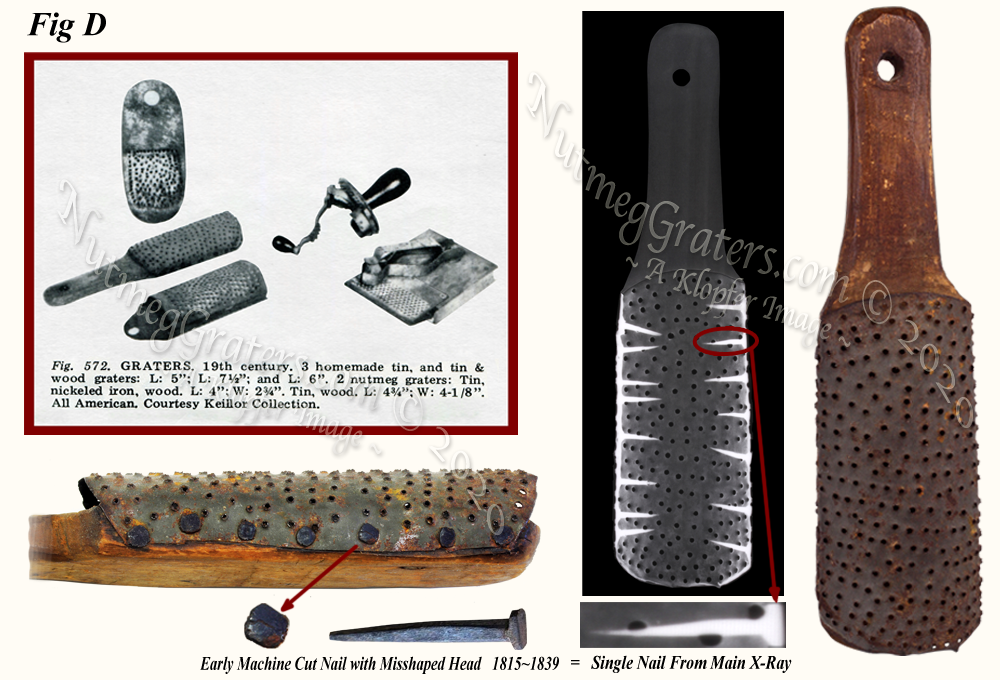
![]()
PRIMITIVE (Fig E) ~ An Oval Handmade Tin Nutmeg Grater:
Unique, Probably American, unmarked, oval shaped tin with irregularly positioned hand-punched teeth, early implement but of unknown date.
STATS: 5¾" long; 2½" width : 0.899 oz. weight.
PROVENANCE: Keillor Collection Auction, O. Rundle Gilbert Auctioneer, On-Site Wading River, Long Island, New York,1976.
PUBLICATION: America In The Kitchen, From Hearth to Cookstove, by Linda Campbell Franklin, Page 115, Fig 572 (SEE: Image Top-Left); 1976.
ANALYSIS: Tinned black-plate with only a residual tin coat remaining; a diagonal graining pattern (both front and back) is evident across the metal's surface. | The oval's outer shape and the circular "hanging hole" were created with exact precision and do not appear hand cut. | The rasp's teeth are hand-punched ~ an orderly and evenly arranged punched border encircles randomly spaced inner punch work. | Long faded on back is "50¢", the likely sale price at a long-ago yard sale.
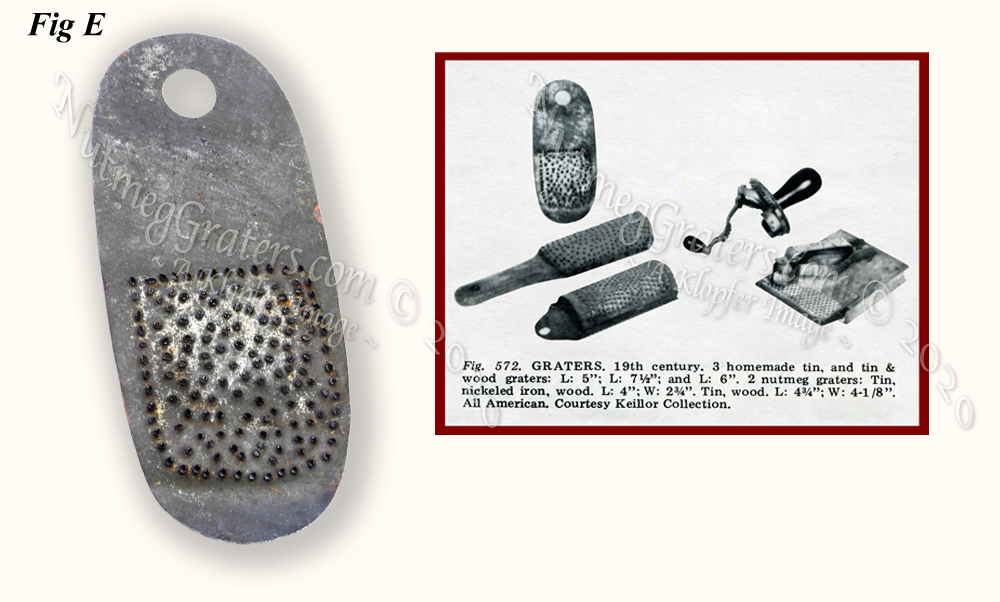
![]()
PRIMITIVE (Fig F) ~ A Long Handled Bottom Grater For Nutmeg:
Unique and American; marked "Uncle Chester\for Mother to make Apple Pie"; pine wood and hand punched tin; "early machine cut nails" of the Circa 1835~1850 type : Data suggests that this grater dates within the 2nd quarter of the 19th century .
STATS: 7¼" long; 1¼" width; 1⅞" height : 1.386 oz. total weight.
PROVENANCE: Absent from its personal history, it is impossible to know from where the bottom grater originates or who "Uncle Chester" was. This item has a present day provenance as an "in-the-trade" acquisition found at an "estate sale" in St. Joseph, Missouri. Located north of Kansas City, MI, "St. Joe" is situated on the Missouri River. First selected in 1826 as a "trading post" site, this area was later opened for public settlement in 1843, and incorporated as a town in 1851. Being a "terminal destination of the railroad", St. Joseph was a major gathering point for westward bound wagon-trains, the first one departing in 1844. This mid-19th century grater might have originated in this location, or is a subsequent-arrival to this location any time thereafter.
ANALYSIS:
Wood Identified (2009): Examined by Woodcrafter Co. wood experts as American "pine". The wood is hand-carved (whittled handle and main-body); Rough hand-tool blade or chisel markings to carve the "inside trough"; and bares broad "parallel pit saw-marks" across its open-ended, suggestive of 1840 ~ 1920+ [inspectapedia.com]). The incredible patina demonstrates significant aging and handling.
ANALYSIS:
Nail Identification: "Early machine cut nails" of the later variety. | Misshaped, flat roundheaded nails (each head has a nonuniform flat surface with uniquely meandering rounded edges), a shank of irregular width and a rounded shank under the nail head [inspectapedia.com]; lacking corrosion. | Nails taper to a point showing an angular cut across the plate with slight variation in length dating roughly between 1835 - 1850 (due to more uniformity in structure, according to Nelson as our main reference; Page 7).

![]()
WHAT MEANS "PRIMITIVE"? ~ SOME THOUGHTS IN CLOSING:
Invented by Samuel Gear in 1876, the common round-faced box grater for nutmeg has existed, little changed, for nearly one-hundred and fifty years ~ being mass-produced into the hundreds of thousands by numerous large corporations around the world. These remain widely available in stores today. Bryant & May LTD of London patented "a completely new process for printing on tins", and their spice boxes remained in production from the 1870's into the 1920's. Henry Saal's Ever-Ready, and the Damon brother's The Edgar nutmeg graters were assembled in production lines, being sold by the multiple gross in a single sale. However today, images of these same mass-produced items regularly are advertised for sale as "PRIMITIVE" (These described items shown here: Fig F); this includes some items in modern aluminum or stainless steal; sometimes marked "Taiwan". One can not help but wonder what Mr. Gear, Mr. Bryant, Mr. May, Mr. Saal, the Damon brothers, or any of the other manufacturers of these mass-produced items might think about their inventions being marketed during the early 21st century as "PRIMITIVE"!
NutmegGraters.Com recognize that culinary implements are items historically used by and attributed to the female gender, and therefore, it is wondered how this relates to one's terminology for these products? So, what is your definition, criterion and understanding for determining that a nutmeg grater is, or is not a "primitive"? We would like to know! Any thoughts?
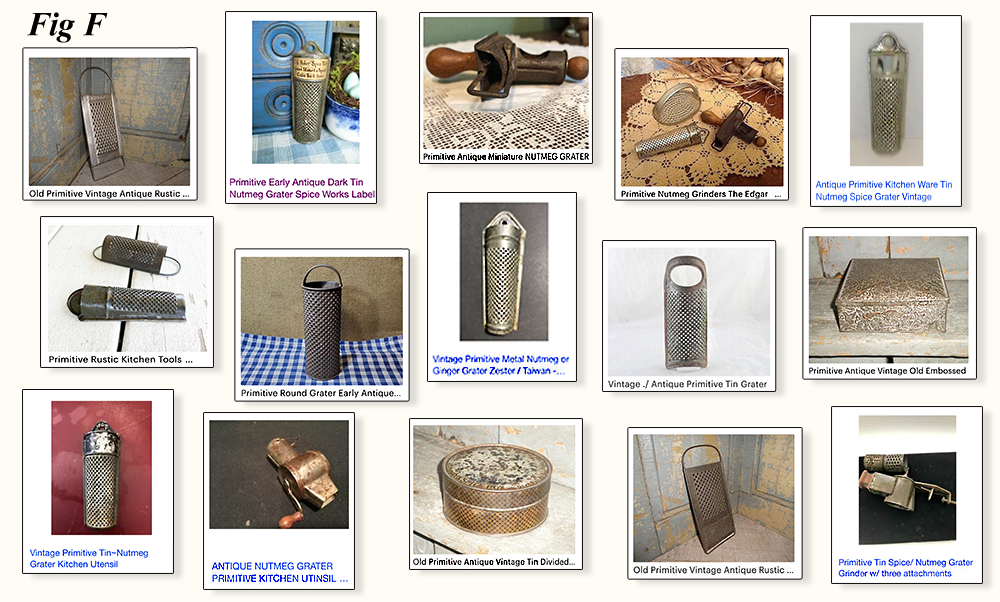
[KLOPFER article © September 2020 & 2023]
